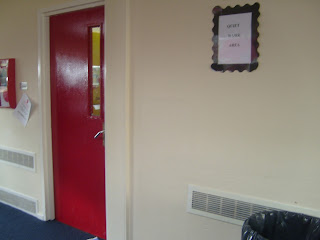Scene 1
Opens with a shot of Lauren (main character) on her own in the common room. She is in the foreground and behind her you can see a group of people looking and laughing. She has an annoyed look on her face, there is then a
racking focus as the group leader throws a scrunched up ball of paper at her. When it hits her the bully says, "Oh sorry, did I hit you, I was aiming for the bin." The way she says it is clearly sarcastic.There is then another
racking focus back to the main character looking even more annoyed as she hurriedly picks up her things and leaves the room. The shot
tracks her as she leaves and you can hear the group in the back laughing as she goes. The audience can see Chloe (pen-friend/bully) looking clearly uncomfortable at the bullying in the background but the audience and Lauren don't know her true identity yet.
Scene 2
Opens with Lauren walking home and into her house quickly as if in an excited hurry. (mid-long shot of her walking along the street) Once inside she dumps her bag and rushes to her computer. (close up of bag as it is dumped) She presses the on button (close up of her pressing button) and is clearly impatient as it loads. (mid-shot of her next to her computer as it loads) Once it's loaded she starts a conversation with her pen friend...
INSERT PHOTO OF MY HOUSE
(close up of the screen as Lauren opens the programme and types/sends the first message. Close up of screen continues as the conversation ensues)
Lauren (L): Hey :D
Chloe - Cool-chick (C-C): Hey :D
L: What you been up to?
C-C: Not much, school...you?
L: Same...what is the point?
C-C: I know right!?
L: I've been thinking...maybe we should meet up?
C-C: Yeah, why not? :D
L: :D Ok, when?
C-C: How about we meet tomorrow in the park? 4pm?
L: Sounds good to me! :D
C-C: Cool! Can't wait :D
L: Me neither! :D
The scene ends with a
circular tracking shot of her sitting talking on her computer having clearly more fun than at school
Scene 3
The next scene is Lauren waiting on a swing in the park for her pen-friend to arrive.
(mid-long shot of her sitting on the swing looking at her phone) She keeps checking her watch and looks a little nervous.
(close-up of watch face showing the time as 5:00) She then looks up to see her Chloe walking towards her.
(long shot of her friend) The camera then zooms into the Chloe's face and the audience can see that she is one of the ones bullying Lauren.
(close up) Chloe looks worried because she knows that the person she enjoys talking to so much is the person she lets be bullied at school. Switches to a
close up of the Lauren's face. She looks shocked and hurt. Switches back to a
close up of the Chloe as she says "Hi" nervously. Switches back to Lauren who shakes her head and runs away beginning to cry.
Scene 4
The next scene is in the corridor.
Mid-shot of the Lauren walking down the hall. She see's Chloe who smiles at her and Lauren puts her head down and walks off quickly. Audience can see Chloe looking upset over the Lauren's shoulder. It then switches to a
close up of a computer screen again and shows a series of messages from the Chloe to the Lauren. Each says a different time during the day.
C: I'm so sorry
C: Please don't ignore me
C: Please, meet me in the park at 4:00 I just want to explain
Switches to a shot of the Lauren looking at the screen and then turning to look at the door considering.
(over the shoulder shot)
Scene 5
The next scene is Lauren walking around the corner ready to meet Chloe.
(point of view shot) As she rounds the corner Chloe comes into view and stands up when she sees Lauren coming. Lauren walks straight past and goes to sit on the swing behind Chloe.
(mid-long shot) Chloe sits down next to her and begins explaining herself.
C: I'm really sorry (looks over at Lauren)
L: Why didn't you tell me? (looking at the ground)
C: Because I didn't think you'd believe me if I suddenly came over and said 'Hi, I'm your pen-friend can I sit with you?' (looks away from the main character and begins twiddling her thumbs whilst looking at the ground)
L: Why didn't you stick up for me? (looks at her sharply before looking away again)
C: I don't know. I wish I had...I know I should have done and I know you probably hate me but I really miss talking to you. You're a really great person and a really good friend. Please just let me sit with you. (looks at the Lauren pleadingly)
L: (Lauren looks up at Chloe contemplating.) You know they'll start bullying you too?
(close up of Lauren as she says this)
C: I don't care, we can stand up to them together
(close up of Chloe as she replies)
L:
(close up of Lauren as she smiles) Ok then
(They hug)
Scene 6
The final scene is Lauren and Chloe walking into the common room together,
(mid shot/tracking shot of them walking in) and the bullies looking at the Chloe like she's infected.
(mid-shot of the Chloe's old group looking disgusted) Chloe and Lauren ignore them no longer caring and the scene ends.
(mid-shot of them looking over their shoulders, maybe waving mockingly)














































